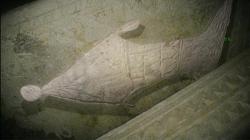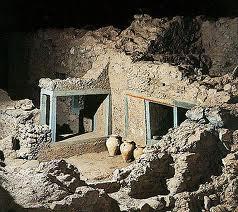INSTITUT SUPERIEUR D'ANTHROPOLOGIE
INSTITUTE OF ANTHROPOLOGY
ONLINE COURSES / COURS A DISTANCE
INSCRIPTION 2012 / Session III : Juillet 2012
REGISTRATION 2012 / Term III : July 2012
ROYAUME UNI –  Newport - Archaeologists have discovered the remains of a Neolithic portal dolmen, one of Western Europe's oldest ritual burial chambered monuments, in an isolated field in Wales. It is thought the tomb was built from giant boulders about 5,500 years ago. Its capstone bears a seemingly random pattern of dozens of circular holes gouged into its surface – symbols of Neolithic or Bronze Age ritual burial activity. What makes it particularly interesting is that the site has rare remains of human bones and shards of decorated pottery. An official burial licence must now be sought before the bones can be removed, but eventually radiocarbon-dating and other tests planned for the remains may give new insight into our early farming ancestors. The archaeological excavation near Newport in Pembrokeshire has been led by George Nash, Thomas Wellicome and Adam Stanford, who plan to resume work in September. While the tomb is thought to date from 3,800BC, the pottery with its grooved design appears contemporary with late Neolithic activity, Dr Nash believes. Further finds include two perforated, sea-worn shale beads, each about 4.5cm in diameter, which are thought to be some form of jewellery. Dr Nash has linked them to hundreds of examples found in the 1970s at a nearby coastal settlement from the Early Mesolithic period 9,000 years ago. He believes his Neolithic site may have even older, Mesolithic origins. The marked stone – now thought to be the capstone of the dolmen – was long ago tilted on its side in a field off the beaten track. Although its existence was recorded in 1929, and it was designated as a scheduled monument, it was just thought to be an ancient standing stone some 1.2m high. Dr Nash said: "In 1972, the archaeologist Frances Lynch [only] referred to the site as a possible portal dolmen site because of the shape of the capstone. She did no geophysical survey, no excavation. It was just a speculative comment. Until we dug it, this site had never been investigated."
Newport - Archaeologists have discovered the remains of a Neolithic portal dolmen, one of Western Europe's oldest ritual burial chambered monuments, in an isolated field in Wales. It is thought the tomb was built from giant boulders about 5,500 years ago. Its capstone bears a seemingly random pattern of dozens of circular holes gouged into its surface – symbols of Neolithic or Bronze Age ritual burial activity. What makes it particularly interesting is that the site has rare remains of human bones and shards of decorated pottery. An official burial licence must now be sought before the bones can be removed, but eventually radiocarbon-dating and other tests planned for the remains may give new insight into our early farming ancestors. The archaeological excavation near Newport in Pembrokeshire has been led by George Nash, Thomas Wellicome and Adam Stanford, who plan to resume work in September. While the tomb is thought to date from 3,800BC, the pottery with its grooved design appears contemporary with late Neolithic activity, Dr Nash believes. Further finds include two perforated, sea-worn shale beads, each about 4.5cm in diameter, which are thought to be some form of jewellery. Dr Nash has linked them to hundreds of examples found in the 1970s at a nearby coastal settlement from the Early Mesolithic period 9,000 years ago. He believes his Neolithic site may have even older, Mesolithic origins. The marked stone – now thought to be the capstone of the dolmen – was long ago tilted on its side in a field off the beaten track. Although its existence was recorded in 1929, and it was designated as a scheduled monument, it was just thought to be an ancient standing stone some 1.2m high. Dr Nash said: "In 1972, the archaeologist Frances Lynch [only] referred to the site as a possible portal dolmen site because of the shape of the capstone. She did no geophysical survey, no excavation. It was just a speculative comment. Until we dug it, this site had never been investigated."
http://www.independent.co.uk/life-style/history/secrets-of-the-earliest-britons-could-be-hidden-in-5000yearold-tomb-7628109.html
ISRAEL –  Jerusalem - Archaeologists working in Jerusalem claim that a discovery they made inside a burial tomb, dating back to the time of Jesus Christ, could shed new light on the origins of Christianity. Biblical historian James Tabor, professor and chair of religious studies at the University of North Carolina in Charlotte, is working with the team, led by controversial filmmaker Simcha Jacobovici. Using a camera mounted on a robotic arm, the team found a 2,000-year-old engraving, which they claim depicts Jesus' resurrection, on an ossuary -- a limestone burial box that contains human bones -- in a first-century tomb.
Jerusalem - Archaeologists working in Jerusalem claim that a discovery they made inside a burial tomb, dating back to the time of Jesus Christ, could shed new light on the origins of Christianity. Biblical historian James Tabor, professor and chair of religious studies at the University of North Carolina in Charlotte, is working with the team, led by controversial filmmaker Simcha Jacobovici. Using a camera mounted on a robotic arm, the team found a 2,000-year-old engraving, which they claim depicts Jesus' resurrection, on an ossuary -- a limestone burial box that contains human bones -- in a first-century tomb.
http://abcnews.go.com/International/jesus-tomb-controversy-rages-archeologists-explore-2000-year/story?id=16111993#.T4WsFas5Lbo
GRECE –  Santorin - The archaeological site of Akrotiri on the island of Santorini will reopen its gates to the public after remaining closed for almost seven years. In 2005, a roof in the prehistoric settlement collapsed, killing a male tourist and injuring another six people. After several years of restoration work at the site, the roof has been replaced and the site will open this week. The Minoan Bronze Age settlement is named after a modern Greek village situated on a hill nearby. The name of the site in antiquity is unknown. According to the Greek Ministry of Culture, the first habitation at the site dates from the Late Neolithic times (at least the 4th millenium B.C.). During the Early Bronze Age (3rd millenium B.C.), a sizeable settlement was founded and in the Middle and early Late Bronze Age (ca. 20th-17th centuries B.C.) it was extended and gradually developed into one of the main urban centres and ports of the Aegean. The large extent of the settlement (ca. 20 hectares), the elaborate drainage system, the sophisticated multi-story buildings with magnificent wall-paintings, furniture and vessels, show its great development and prosperity. The various imported objects found in the buildings indicate the wide network of its external relations. Akrotiri was in contact with Crete but also communicated with the Greek Mainland, the Dodecanese, Cyprus, Syria and Egypt. The town’s life came to an abrupt end in the last quarter of the 17th century B.C. when the inhabitants were obliged to abandon it as a result of severe earthquakes. The eruption followed. The volcanic materials covered the entire island and the town itself. These materials, however, have protected the buildings and their contents, like is done in Pompeii.
Santorin - The archaeological site of Akrotiri on the island of Santorini will reopen its gates to the public after remaining closed for almost seven years. In 2005, a roof in the prehistoric settlement collapsed, killing a male tourist and injuring another six people. After several years of restoration work at the site, the roof has been replaced and the site will open this week. The Minoan Bronze Age settlement is named after a modern Greek village situated on a hill nearby. The name of the site in antiquity is unknown. According to the Greek Ministry of Culture, the first habitation at the site dates from the Late Neolithic times (at least the 4th millenium B.C.). During the Early Bronze Age (3rd millenium B.C.), a sizeable settlement was founded and in the Middle and early Late Bronze Age (ca. 20th-17th centuries B.C.) it was extended and gradually developed into one of the main urban centres and ports of the Aegean. The large extent of the settlement (ca. 20 hectares), the elaborate drainage system, the sophisticated multi-story buildings with magnificent wall-paintings, furniture and vessels, show its great development and prosperity. The various imported objects found in the buildings indicate the wide network of its external relations. Akrotiri was in contact with Crete but also communicated with the Greek Mainland, the Dodecanese, Cyprus, Syria and Egypt. The town’s life came to an abrupt end in the last quarter of the 17th century B.C. when the inhabitants were obliged to abandon it as a result of severe earthquakes. The eruption followed. The volcanic materials covered the entire island and the town itself. These materials, however, have protected the buildings and their contents, like is done in Pompeii.
http://greece.greekreporter.com/2012/04/10/the-archaeological-site-of-akrotiri-in-santorini-to-reopen/
USA - Newtowne Neck - A team of archaeologists and volunteers is close to locating a 1662 chapel at Newtowne Neck in Compton. Scott Lawrence of Grave Concerns and James Gibb of Gibb Archaeology Consulting were hired by St. Francis Xavier Catholic Church and the Knights of Columbus to look for the original chapel. The two have completed an archaeological survey of the church’s original cemetery. St. Francis Xavier is celebrating the 350th anniversary of the original church chapel this year. The current chapel dates to 1731, but the Jesuits started a mission in Newtowne Neck in 1640, Gibb wrote in an assessment, well before the county seat of Leonardtown was established in 1708. The archaeology team focused on the church’s cemetery, which is about a half-mile north of the current chapel. The cemetery’s location indicated that’s where the original church once stood. There are many more graves there than the existing headstones would indicate, the excavation has determined. As the team searched for evidence of the chapel, numerous burial sites were discovered. As teams exposed 5-foot-by-5-foot sections of earth down to about 6 inches, rectangular layers of clay were found. The rest of the Colonial-era soil is dark brown. As graves were dug, the clay below was disturbed and mixed in with the disturbed soil, Gibb said. The clay is thicker and a lighter brown. Lawrence and Gibb were looking for post holes, which indicate a building previously stood there. A post hole would contain disturbed clay and have an area of dark, decomposed material in the center, Lawrence said. On April 1, the team found broken glass and wrought nails. In addition, “we might have a structural post hole,” Lawrence said April 2. Pieces of glass showed where the lead panes intersected and, based on that, the team thinks the 1662 chapel had diamond-shaped window panes, Lawrence said. Parishioners at the original chapel would have arrived by boat on the water by the creek next to the cemetery, Lawrence said. That creek now is silted in and became wetlands. In the late 1600s, there were about a dozen Catholic families in the Newtowne Neck area.
VIDEO = http://www.washingtonpost.com/local/archaeology-team-following-clues-to-1662-chapel/2012/04/10/gIQA0t0HAT_story.html